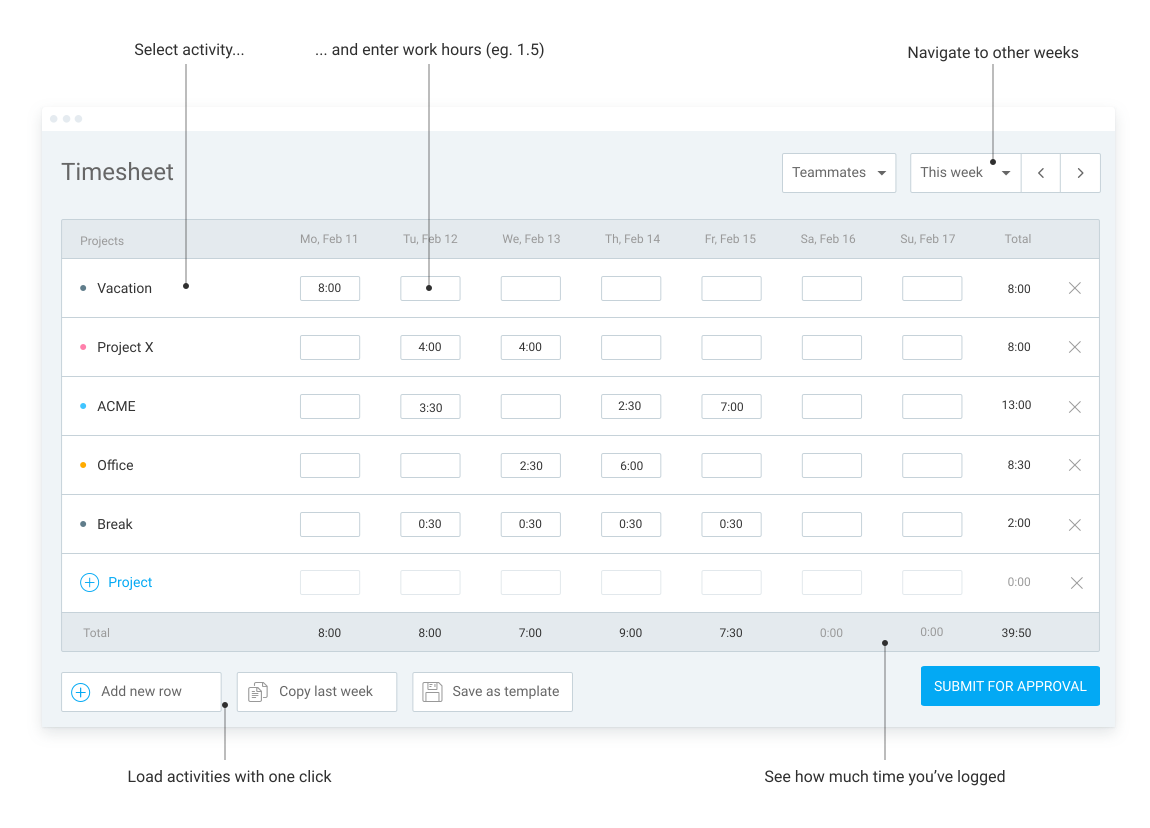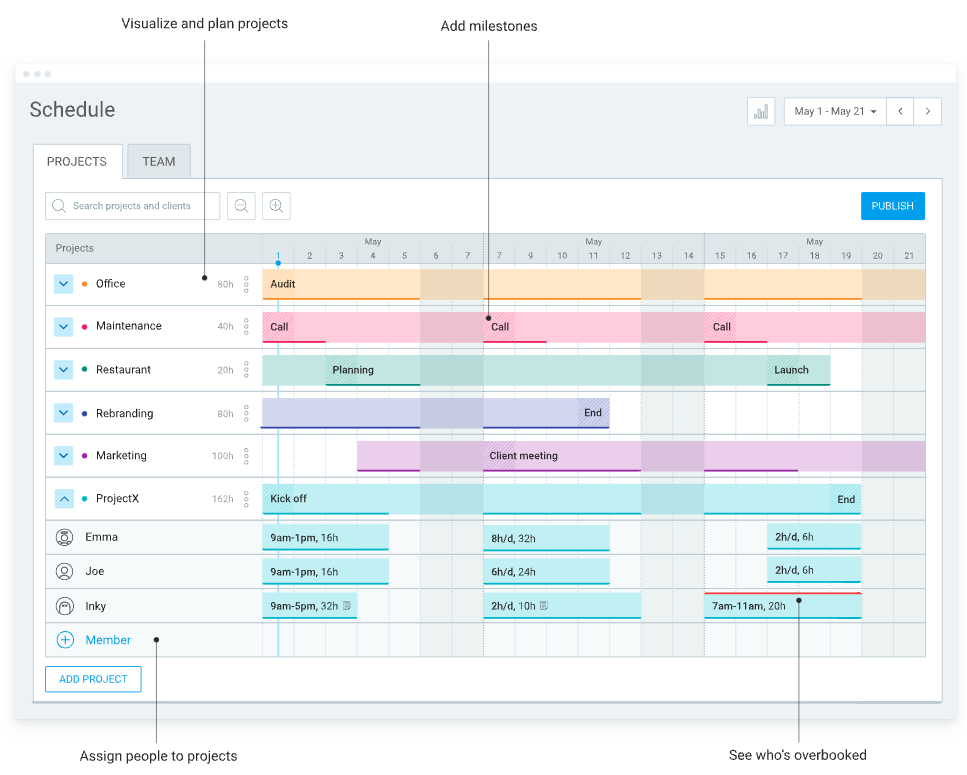El manual completo para la licitación de construcción (+ pasos y consejos)
The project will be done on time and on budget — that’s the most ear-pleasing sentence that property owners want to hear from their construction contractors.
But how can contractors and their sidekicks (subcontractors) make it all happen?
Well, that’s why you’re here.
In this article, we’ll cover:
- What construction bidding is and how it works,
- Why efficient bidding is critical for profit, and
- How to follow some crucial steps in construction bidding for the best results.
Let’s dive right in.

Tabla de contenidos
What is construction bidding?
Construction bidding is a procedure where general contractors (GC) submit formal written offers to clients (also known as property owners or project owners) to complete a construction project within a given timeframe.
In other words, a client asks general contractors to bid on their projects in order to get hired to do a job. In industry slang, experts refer to this as bid solicitation (more on that later). After bid solicitation, the general contractor talks to subcontractors to check their availability and get more detailed information on specialized services, like plumbing or electrical.
As we already mentioned, the terms property owner, project owner, and client are used interchangeably and mean the same thing — the person or entity that solicits, reviews, and approves bids from contractors.
To survive on the market, a construction company has to learn to prepare a competitive contractor bid. But competitive doesn’t only mean the bid with the lowest price. In fact, the word competitive usually entails a carefully crafted blend of cost, profit, and quality.
Thus, the goal of any contractor during construction bidding is to win as many contracts as possible by balancing the following aspects:
- Money they earn from doing the job,
- Cost of the material and labor, and
- Quality they deliver to the client.
Contractors submit their bids during tenders, but more on that later.
Next, let’s take a look at how to differentiate between construction bidding and construction estimating.
Construction bidding vs. estimating
Making a profit in the construction industry is hard.
According to a report by the National Association of Home Builders, construction companies scored a net profit of just 7% in 2020 (which is the total earnings after deducting all expenses from the income generated).
To earn more, contractors can’t just bid on more projects — and that’s where bidding and estimating jump on stage.
Construction estimating is part of construction bidding. More precisely, estimating requires the contractor to forecast expenses for building the structure. After collecting the cost information for labor and materials, the contractor feeds it into their construction bid. In all cases, estimating precedes bidding.
If done wrong, estimating may lead to significant losses after signing the contract with the property owner. For a project to make a profit, here’s a short list of items that need to go into cost estimation:
- Equipment, materials, and labor,
- Feasibility studies,
- Insurance and taxes,
- Field supervision,
- Testing and inspection, etc.
Besides, bidding and estimating require a mutually distinct set of skills.
For example, the person overseeing the bidding process needs to nurture a strategic mindset and thereby:
- Look at the project from a bird’s-eye view, and
- Set measurable and realistic objectives.
In contrast, the individual in charge of the estimation of costs — also called estimator and cost estimator — has to be a magician in task delegation and project management.
What’s more, smaller contractors often pay one person to handle their contractor bid and estimating procedures. Yet, that’s not the best way to go, especially for large and recurring projects. Construction experts typically recommend hiring separate professionals to handle the bid and estimation.
We created a simple table below to make the major traits of construction bidding and construction estimating more tangible:
| Construction bidding | Construction estimating |
|---|---|
| Entails submitting a formal offer to a property owner or potential client to build a structure (like a building) | Focuses on assessing potential costs for building the structure; experts often refer to estimating as approximating total project costs (the emphasis is on approximation) |
| Focuses on the official proposal aimed at developing and managing the construction of a building | Calculates internal contractor costs in building the structure, like costs of deliveries, labor, materials, insurance and taxes, and other expenses |
| Constitutes a strategic activity and requires leadership skills — it’s like asking yourself “Where should my business head next?” | Constitutes a tactical activity requiring managerial skills — like asking yourself “Do I need to hire my best subcontractors to help on this project?” |
| Comprises the legal commitment to the client when the construction bid is sent | Serves not as a legal commitment to the client but rather as a reference point for expenses |
Types of construction bids
A construction bid is a series of documents sent to the client for review and approval. Apart from the cost estimation, a construction bid includes the scope of work for the whole project.
Property owners and other clients solicit contractor bids from contractors via 5 bidding types, also called tendering options or tenders:
- Open tendering,
- Negotiated tendering,
- Selective tendering,
- Serial tendering, and
- Framework tendering.
To clarify, a tender is an invitation to participate in a competition and win a contract. On the other hand, a bid is the contractor’s response to the tender — i.e., the contractor collects documentation needed to compete for the contract.
In short, tenders and bids are 2 sides of the same coin. In the following paragraphs, we’ll cover the 5 tendering options in more detail.
Let’s dive right in.
Construction bid type #1: Open tendering
Open tendering (also called open bidding) means that the property owner invites all interested contractors to submit their bids. Hence its name — open tendering, where anyone can submit a contractor bid.
Property owners usually use open tendering on government projects.
For larger projects, clients may establish a pre-qualification process to hire the most suitable contractors for the job.
According to Kumar Neeraj Jha, a construction expert and author of Construction Project Management: Theory and Practice, open tendering is a low-stakes game to a certain extent:
“The risk involved in the project is less here. The owner specifies some minimum eligible criteria for issue of the tender document. If these criteria are satisfied by a contractor, the tender document is issued to him.”
Pros of open tendering in construction:
- Provides greater accountability and transparency than other bid types, and
- Allows up-and-coming general contractors to land their first projects.
Cons of open tendering in construction:
- Highly competitive as it is open to anyone interested in applying, and
- Sometimes criticized as costly for contractors after they get involved in the tendering process.
Construction bid type #2: Negotiated tendering
With negotiated tendering, the client approaches one contractor to bid on the project. Some of the reasons for this include the contractor’s track record and their previous relationship with the client. In other words, the project owner has more trust that the contractor will do as they claim in their construction bid.
In most cases, clients pick the negotiated tendering option for highly specialized projects, like building factories, warehouses, or power plants.
Unlike open tendering, where everyone gets to take part in the bidding process, negotiated tendering can be anti-competitive and exclusive.
Pros of negotiated tendering in construction:
- A great option for providers of highly specialized construction projects, and
- In case of security concerns and emergencies, clients prefer negotiated tendering.
Cons of negotiated tendering in construction:
- Some experts think it lacks accountability due to its exclusivist nature, and
- Leads to a reduction of available jobs to other contractors.
Construction bid type #3: Selective tendering
Selective tendering is a more complex, advanced form of negotiated tendering. Simply put, selective tendering means that the client approaches a select, experienced, and trusted group of contractors to bid on the project. That’s unlike negotiated tendering — where the client approaches a single contractor.
When a restricted number of bidders is invited to bid, the property owner retains the right to select the bids they want — no matter their high prices. We can understand selective tendering as a pre-selection phase of suppliers who compete to win the project.
In fact, selective tendering is the most common type of tendering on private construction projects. Some of the main criteria that clients consider with this type of tendering include:
- Performance on past projects,
- Relationship with the client, and
- Expertise in specific fields.
In any case, a selective tender ensures greater quality control for the client.
🎓 Consejo Pro de Clockify
Find out everything about the cost of quality — and the 3 steps you need to take to ensure high-quality control in project management:
Pros of selective tendering in construction:
- More efficient than open tendering since it takes very little time, and
- Only truly qualified general contractors get an invitation to submit a bid.
Cons of selective tendering in construction:
- May introduce bias since clients are prompted to constantly go back to the same contractors, and
- The price of the contract is typically higher than during open tendering.
Construction bid type #4: Serial tendering
Serial tendering is one of the rarest approaches but still applicable in some cases. Serial tendering happens when the property owner wants to get a series of similar projects done within a specific timeframe.
A good example of serial tendering is when a housing developer plans to build dozens of residential homes in a single year. To avoid the backbreaking work of selecting bids for every separate project, they opt for choosing just one general contractor to handle all those similar housing contracts.
Pros of serial tendering in construction:
- Many experts believe it’s less costly for both the client and the contractor, and
- Timely payments by the client due to breaking up payments into increments.
Cons of serial tendering in construction:
- Contractors often have to wait for weeks or even 1-2 months to hear back from the client, and
- Long-term planning turns into a nightmare, because of lots of uncertainty.
Construction bid type #5: Framework tendering
With framework tendering, the project owner compares several bids against quality and prices.
As a second step, they pick 2 or more contractors to execute the construction project. In other words, each bidder — i.e., contractor — gets their rightful place in the project scheme. For instance, one contractor may work on internal design, in contrast, the second contractor could be charged with handling the fences and outside aspects of a project.
In some cases, connoisseurs refer to framework tendering as joint ventures. In any event, this type of construction bid mostly concerns itself with complex and large projects.
Pros of framework tendering in construction:
- A great starting point for future government-funded projects, especially in the EU, and
- Due to their length, contracts can provide long-term revenue for the contractor.
Cons of framework tendering in construction:
- Bidders often invest a lot of money and efforts to get this type of contract, but sometimes they don’t win the bid, leading to serious financial issues, and
- Unlike other construction bid types, framework tendering lacks the flexibility in terms of customization and negotiation.
—
Now that we got bid types out of the way, let’s explore a few tried-and-tested steps you can take during construction bidding.
What are the steps in construction bidding?
To succeed in construction bidding, contractors must follow a strict series of actions.
In the following paragraphs, we’ll present 6 steps that general contractors should follow to win more bids, including:
- Soliciting bids,
- Subcontracting,
- Submitting bids,
- Selecting bids,
- Forming and signing the contract, and
- Delivering the project.
Without further ado, let’s get started with the most important steps in construction bidding.
Step #1: Soliciting bids
As a first step, property owners invite general contractors to submit construction bids. Industry specialists often call this the bid solicitation stage.
At this point of the bidding process and depending on the tender type, the general contractor needs to consider the following documents:
- Request for proposal (RFP): an official client-issued document announcing the project, clarifying the project’s scope, and inviting contractors to submit bids,
- Request for quote or qualifications (RFQ): a formal process where a client asks a group of selected contractors to submit bids for construction projects, and
- Invitation for bid (IFB): an official document that general contractors send to subcontractors with a request to provide pricing for specialized construction services.
These application packages also include information like specifications, drawings, questionnaires, bid date and time — and sometimes even a draft contract. In fact, the client may also share information on whether the project will be public (government-issued) or private (commercial).
Apart from company-related documents for the general contractor, the client often requests subcontractor information as well. After all, the client wants to know who they’ll be dealing with day in and day out.
The bidding process starts as soon as all bid documents are shared with bidders, like RFP, RFQ, and IFB, as we mentioned above.
🎓 Consejo Pro de Clockify
Construction accounting plays a vital role in calculating costs and profits every step of the way — including bid solicitation. Read our in-depth guide on construction accounting right here:
Step #2: Subcontracting
In the second step of the bidding process, the general contractor asks subcontractors for bids to perform specialized services for the project. For example, these may include plumbing, electrical, and related technical services.
As soon as a subcontractor submits bids to the general contractor, the latter feeds all subcontractor information into the official construction bid which is sent to the client in the following bidding phase.
During this subcontractor bidding process, the general contractor often selects subcontractors they’ve worked with on past projects. Apart from that, the general contractor also skims bid websites (with databases of subcontractors) to get the best subs, as they’re often referred to in industry slang.
With the information on costs collected from the subcontractors, the general contractor estimates a realistic cost using the following construction bidding tools:
- Blueprints or construction plans: a detailed drawing of the project’s particulars,
- Material quantity takeoffs: a list of physical materials the contractor needs to complete the construction project, and
- Bill of quantities: an in-depth description of each cost for the project.
According to Kumar Neeraj Jha, the author of the construction book we referenced earlier, subcontractors make up a vital part of the construction puzzle:
“The process of managing the subcontractor right from their selection till the subcontract is closed out is essential for the success of a project, given the fact that in some projects more than half of the project value is subcontracted.”
Step #3: Submitting bids
The third step in the bidding process involves contractors busting out their calculators and submitting their documentation on project costs, project timeline, and their business information. It’s like a beauty pageant — but for construction companies.
In any case, remember that the bid documents should be easy to follow and include items such as:
- Materials and equipment,
- Labor costs,
- Overhead costs,
- Subcontractor expenses, and
- Profit margin.
When contractors consider this information, they are more likely to offer a competitive bid to the client.
But whatever you do in the bidding process, never forget to include precise timelines.
In some projects, the client requests that the general contractor submit a bid bond together with the bid. The bid bond guarantees that the project will be completed as per the submitted bid.
Bonus tip: Collect your insurance documentation, like general liability insurance, workers’ compensation insurance, and builders risk insurance. If the contractor submits this documentation, they can increase the chances of winning the project.
Step #4: Selecting bids
The next step entails selecting a few competitive bids (or just one) that grab the client’s attention. Typically, clients use a scoring system to rank all bids.
As a rule of thumb, non-government project owners consider the following strong points of a contractor, including:
- Price and detailed cost explanations,
- Scheduling philosophy, such as workflow optimization,
- Experience on similar contracts,
- Personnel resumes of staff members,
- Safety records for past projects, and
- Other criteria relevant to the project.
In rare cases, the client may want to interview the general contractor in more depth.
The same principles apply to government-funded projects as well, but with a big difference — government clients give priority to price over all other aspects.
During bid selection, the client implements bid leveling. Bid leveling simply entails a concerted effort by the client to standardize their bid format. In turn, bid leveling enables the client to properly compare the differences and similarities between a wide range of bidders.
Step #5: Forming and signing the contract
As soon as the client has selected the most suitable bid, they’ll discuss all terms and the final pricing structure with the general contractor. So, yes, contractors often have room for negotiation between bid submission and contract formation.
To make things clearer, the contract needs to contain the following:
- Contract drawings,
- Detailed project specifications,
- General conditions of contract,
- Special conditions of contract, and
- Agreement (i.e., actual document signed by both parties).
To get the most out of the project, contractors should consult legal experts first. The reason is that a construction contract is only valid if it considers 3 legal aspects, including:
- Offer: one entity vows to do one thing in exchange for the other entity doing another thing,
- Acceptance: all parties agree to all terms from the original offer (i.e., contractor bid), and
- Consideration: the contract has to be mutually beneficial or, in other words, both entities have to receive benefits and provide value.
So far, so good? Great!
Let’s get to the sixth and final step in construction bidding.
Bonus step: Delivering the project
Although not officially part of the bidding process, project delivery can reveal how professional and knowledgeable the contractor actually is. If the project is done well, the contractor may expect to be hired by the same client in the future.
Simply put, the general contractor selects the project delivery method before the bidding starts. The chosen project delivery method has a role to play before, during, and after bidding.
In a nutshell, methods of project delivery include:
- Design-Bid-Build: the traditional method wherein the property owner hires a designer separate from contractors. As soon as the project design is ready, the property owner solicits bids from contractors to implement the design.
- Construction Management at Risk (CMAR): different firms are in charge of design and construction.
- Design-Build (D-B): a single contractor takes care of construction and design.
- Integrated Project Delivery (IPD): as one of the newest methods in project delivery, the IPD method means that the property owner, architect, and contractor work as a big team to share the risk among themselves equally.
By carefully selecting the project delivery method, the general contractor can ensure that their project is completed efficiently, on time, and within budget.
🎓 Consejo Pro de Clockify
Track time on construction tasks seamlessly with this time clock software:
How to bid on construction jobs (+ expert tips)?
Since you’re reading this article, you probably have a few doubts about construction jobs. So, we consulted experts and dove deep into the literature.
In particular, we’ll explore a few sound tips to supercharge your construction bid as a contractor.
Let’s get to it.
Tip #1: Evaluate project requirements
Competitive bidding is all about knowing which projects to bid on and which ones to skip.
In other words, be realistic — don’t bid on projects you know you’ll have difficulty implementing.
While you’re at it, find out as many details as possible about the items from this construction bid checklist:
- Relevant documentation,
- Existing conditions of the construction site,
- Schedule,
- Project scope,
- Terms of payment,
- Costes, y
- Contact information.
Kumar Neeraj Jha, the author of Construction Project Management: Theory and Practice we mentioned a couple of times already, differentiates between what he calls the right and wrong contractor:
“The terms ‘right’ and ‘wrong’ contractor are subjective. The term ‘right contractor’ signifies ‘fitness of purpose’ for the proposed project. The term ‘right contractor’ has nothing to do with a large or small contractor, since it may so happen that the large contractor may not be the right contractor for a proposed project if it is of low value.”
So, note that you may be the right fit for the project even though you are a small contractor.
Bonus tip: When subcontractors or contractors are unsure about specific project areas, things can easily go sideways. That’s why we recommend always checking with the clients to avoid any confusion. In fact, unaddressed uncertainties can lead to catastrophic losses in money and time.
Tip #2: Estimate costs
Proper cost estimation is the bread and butter of successful construction bids. In fact, countless companies still struggle with things like market price changes, inadequate risk management, and deficient resource management — all leading to subpar cost estimates (expected project expenses).
To learn more about cost estimates, we contacted Greg Batista, CEO of G. Batista Engineering and Construction. Greg emphasized the importance of ensuring that bids take into account all relevant factors:

“Precise cost estimation — encompassing materials, labor, and contingencies — ensures competitive and realistic bids.”
But apart from that, general contractors must remember that preparing cost estimates isn’t cheap. Authors of Estimating Building Costs claim that cost estimates can make or break your business operations:
“The cost of preparing estimates is accounted for under general overhead or the cost of doing business. If a contractor is unsuccessful in too many bids, then the cumulative cost of estimating is high and the volume of work on hand will curtail business growth and threaten corporate survival.”
So, be wise with respect to which projects you bid on!
Tip #3: Showcase experience
In almost all cases, the property owner will ask the contractor to present them with compelling evidence of executing similar projects in the last few years. In other words, field experience and good reference material from other clients make all the difference.
Construction expert Greg Batista had a few more nuggets of wisdom to share when he said that presenting yourself as an experienced contractor — with documentation to back it up — always pays dividends:

“Highlighting past successes, certifications, and unique qualifications builds trust with clients. Tailoring each bid to the specific project demonstrates professionalism and dedication, increasing the likelihood of winning contracts.”
Speaking of experience, the best unit of measurement for assessing your successful bids is the bid-hit ratio. This measure lets you in on your won and lost bids. So, what is it?
In a nutshell, a bid-hit ratio documents how many contracts a general contractor has won after bidding. Say your bid-hit ratio is 5:1 — this means that you typically win 1 out of every 5 bids. A decent bid-hit ratio for private projects is 4:1, and a proper bid-hit ratio for public projects adds up to 10:1.
Tip #4: Use software to track time and improve bidding efficiency
During the process of collecting documents and completing other bidding-related tasks, contractors need to efficiently create reliable bids and manage subcontractors. Also, they need software to see costs at a glance and present them to potential clients transparently.
For that purpose, contractors can use Clockify’s construction timesheet to track:
- Overhead,
- Labor,
- Materials, and
- Other costs.

With a digital construction timesheet, contractors can easily:
- See who works on what and when, and
- Mark work hours as billable or non-billable.
Likewise, during the first 3 bid stages, contractors have to invest significant time to collect and submit documentation. To tackle unnecessary delays in managing bid documents, you can make use of Clockify for scheduling purposes.

With Clockify, you can easily arrange time and workforce resources by:
- Visualizing and planning projects in a way that tracks bid solicitation and subcontracting,
- Assigning designers, architects, and subcontractors to projects, and
- Adding milestones.
All these functionalities allow you to continue preparing competitive, on-time bids for the best results with clients.
Tip #5: Get to know the competition (and the client)
In the construction industry, competition is often fierce. General practice suggests that clients need to receive at least 3 contractor bids for the bidding process to qualify as fair (except when the clients themselves pick a single contractor or a group of contractors in the bid solicitation phase).
In reality, many bid solicitations attract dozens — and even hundreds — of bids.
Brian Greenhalgh, the author of the Introduction to Estimating for Construction, writes that it’s all about offering additional value to the client:
“The key objective is to offer better underlying value to a client than the competition, which is done through a combination of: defining client value, establishing supplier relationships, integrating activities, managing costs collaboratively, developing continuous improvement.”
Another solution for outlasting the competition is submitting your bid before everyone else does. Clients are also human. As a result, they’re more likely to review the first 5-10 bids they received in more depth than skimming through hundreds of others.
In a nutshell, you need to better understand how long it takes your competitors to submit their bids. Perhaps you can even learn from them by exploring construction bidding networks and marketplaces.
Tip #6: Take your time with your construction bid
A quote attributed to Benjamin Franklin is that “great haste makes great waste”.
With the constraints we mentioned in the previous section, you also need to learn how to take your time in collecting data for your construction bid. Don’t just fire off your bids in an attempt to bid on as many tenders as possible.
So, it’s about striking the perfect balance between being faster than your competitors and taking sufficient time to prepare a proper bid.
In most cases, clients provide a few weeks for prospective bidders to apply with their construction bid. That’s ample time for evaluating project requirements, estimating costs, and getting to know the competition (and the client).
We reached out to Alaa Abdelhamid — a construction specialist and the CEO of Behind the Hard Hat. Alaa says that a few weeks should be enough time to prepare a decent bid:

“Commercial construction and government projects typically take around 2 to 3 weeks [to bid on].”
Why is efficient construction bidding important?
Efficient construction bidding helps contractors maintain profitability and win more bids. It’s no wonder then that general contractors want to submit more competitive bids in shorter periods. In fact, submitting more competitive bids often translates into more contracts won.
The upcoming segment discusses the 3 greatest benefits of efficient construction bidding. For a general overview, efficient construction bidding:
- Saves time and other resources,
- Increases profit, and
- Amplifies your professional network.
Let’s explore each benefit in more detail.
Benefit #1: Efficient bidding raises the bid-hit ratio
The more efficiently a contractor submits high-quality bids, the more contracts they’ll win. In turn, the bid-hit ratio improves in time.
That’s why construction expert Greg Batista says that efficient construction bidding benefits the general contractor long-term:

“Efficient bidding increases the chances of winning contracts, leading to a steady flow of projects and a stronger market position. Additionally, it saves time and resources, allowing contractors to focus on executing successful projects while maximizing their potential for growth and success in the construction industry.”
Benefit #2: Efficient bidding increases customer satisfaction
When bidders apply for multiple projects with top-notch construction bids, they can significantly increase their earnings.
Yet, at the end of the day, what matters most is how happy the client is with how you handled the construction project.
Construction expert Alaa Abdelhamid we referenced earlier told us that nothing beats merging your industry proficiency and resources for improved profits:

“Efficient bidding — meaning a contractor bids jobs that are aligned with his expertise and resources — leads to a balanced equilibrium between customer satisfaction and the pathway to revenue-enhancing profitability. This methodology culminates in the cultivation of a reputable contractor image, fostering expansion in project acquisition, and ultimately yielding improved margins.”
Bonus tip: To make your bids even more efficient, you can consider bid management as your next upgrade. Simply put, a bid manager is a person solely in charge of reviewing tenders and submitting construction bids to clients. Bid management also helps contractors reduce manual errors and automate repetitive tasks.
Benefit #3: Efficient bidding amplifies your professional network
A huge network of professionals goes a long way in the construction industry. This network can be enhanced by:
- Representatives of potential clients,
- Architects and designers,
- Subcontractors, and
- Other construction vendors and professionals.
For example, general contractors may be familiar with hundreds of subcontractors with whom they can bid on big tenders. So, the sooner general contractors build a wide-ranging professional network, the bigger their chances of being efficient in collecting bid documents.
Also, working with the best of the best says something about you as a contractor. Implicitly, it means that others value working with you. All this translates into trust among prospective clients. In other words, the more high-quality projects you get done with the help of your professional network, the greater the possibility of landing new contracts.
This time, Alaa Abdelhamid thinks that efficient construction bidding is the basis from which all contractors can either make or break their business:

“Efficient bidding acts as a foundation for establishing trust, fostering recurring client relationships, and consequently driving the scalable expansion of the business. It enables the contractor to win more jobs, leading to increased exposure and enhanced collaboration with all stakeholders in the industry.”
So, here are a few quick tips on how to build a professional network in the construction industry:
- Improve work performance so you have something to show for,
- Harness the power of social media to showcase your expertise,
- Build relationships with industry stakeholders, and
- Reach out to prospective clients every once in a while.
—
Note: We advise you to consult with a construction bidding professional before submitting your construction bids. Clockify is not responsible for any losses incurred should this construction bidding guide be used without additional expert guidance.
Wrap-up: A proper construction bid is all about cost estimates and learning about the client and competition
An exemplary construction bid relies on a substantial data set, not on mere hunches.
This article discussed making your next construction bid more competitive and winning more contracts. In short, here are the main takeaways:
- Avoid bidding on every tender you see — some aren’t worth your time and effort,
- Create a pool of dependable subcontractors who can help you with specialized projects,
- Estimate costs in-depth and do it way before you submit your bid,
- Strike a balance between sending your bid before everyone else and overthinking it,
- Consider using time-tracking and construction software to make things run smoothly, and
- Consult experts with industry experience and peers before you send your next bid.
Just don’t forget to wear your tool belt and hard hat during the bidding process. You know, to really sell the image.
Good luck!
Glossary of basic construction bidding terms
- Bid-hit ratio (sometimes called a win rate) — A bid-hit ratio keeps track of how many projects a contractor has won after bidding.
- Bid bond (sometimes called bid security) — A legal guarantee (or agreement) that acts as an assurance that the general contractor will fulfill their obligations on a construction project.
- Construction management at risk (CMAR) — A project delivery method wherein different construction firms are in charge of construction and design.
- Cost estimate — The projected expenses for the project for which the contractor is bidding.
- Design-Bid-Build — A much-used project delivery method wherein the client hires a designer to complete project design before construction can start. Then, the client solicits bids from contractors to implement the design. With this project delivery method, overlaps between construction and design are avoided.
- Design-Build (D-B) — A project delivery method wherein a single contractor takes care of design and construction.
- Guaranteed maximum price (GMP) — The amount the property owner will pay the contractor upon project completion. If the contractor crosses the GMP threshold, the construction manager is taking over all risks, like increased project costs.
- General contractor (GC) — A type of contractor who sends bids to clients and hires subcontractors to complete specialized work.
- Invitation for bid (IFB) — An official document that general contractors share with subcontractors, asking them to provide pricing for specialized construction services.
- Integrated Project Delivery (IPD) — A recently developed project delivery method; it means that the property owner, architect, and contractor work as a large team to share the risk among themselves equally.
- Net profit margin — The number general contractors get when they subtract all expenses from their sales. In other words, it’s how much actual profit they have made.
- Request for proposal (RFP) — An official client-issued document announcing the project, explaining the project’s scope, and asking contractors to submit bids.
- Request for quote (RFQ) — A formal process where a client asks a group of general contractors to submit bids to work on construction projects.
- Subcontractor — A type of contractor that operates under the general contractor; i.e., the subcontractor offers specialized services for which the general contractor pays them, like plumbing.
- Tender and tendering — An invitation of a client to a construction company or general contractor to submit bids for a project.
Fuentes usadas para la tabla:
Apfelbaum, A. (2010). Construction Cost Management: Cost Engineering, Cost Controls & Controlled
Greenhalgh, B. (2013). Introduction to Estimating for Construction
Hanák, T., Drozdová, A., & Marović, I. (2021). Bidding Strategy in Construction Public Procurement: A Contractor’s Perspective https://doi.org/10.3390/buildings11020047
Harvard Law School (2023), How To Avoid a Business Contract Bidding War
National Association of Home Builders (2022); Profit Margins Fall as Balance Sheets Grow https://www.nahb.org/blog/2022/04/eye-post
Neeraj Jha, K. (2011). Construction Project Management: Theory and Practice
Popescu C.M., Phaobunjong K., Ovararin N., (2003). Estimating Building Costs
Salman, A. (2022). Selection of Construction Bidders Using the Analytical Hierarchy Process and Friedman Theory. Frontiers in Built Environment, 7, 815022 https://doi.org/10.3389/fbuil.2021.815022
Wibowo, Mochamad & Astana, I Nyoman & H.A., Rusdi. (2015). An Analysis of Bidding Strategy, Project Performance and Company Performance Relationship in Construction. Procedia Engineering http://dx.doi.org/10.1016/j.proeng.2015.11.015

